 2015, the year of the sheep, is winding down; it’s a nice time to reflect on the changes in reef-keeping that have taken place, whether it’s the introduction of new technology or a change in methodology. Since I like to stay on top of current trends, and will try just about anything once, I’ve decided to compile a list of seven things I tried in 2015 that really stuck.
2015, the year of the sheep, is winding down; it’s a nice time to reflect on the changes in reef-keeping that have taken place, whether it’s the introduction of new technology or a change in methodology. Since I like to stay on top of current trends, and will try just about anything once, I’ve decided to compile a list of seven things I tried in 2015 that really stuck.
Some are products, some are methods, but all signify changes within my aquarium which I kept in place, and that I found enhanced both my captive ecosystem and saved time on aquarium management. They may not be products or methods that debuted in 2015, but for me, 2015 was the year I decided to give them a try.
- The Triton System
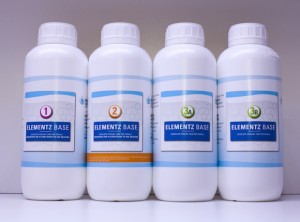 I’ve not even tapped the full potential of the Triton System, but what I’ve used so far has been superb. Triton has been used in Europe for several years, and made its way into the U.S. thanks to Unique Corals. Triton combines full spectrum, laboratory grade water testing with a host of additives. Some consider it a reef tank methodology that removes the need for water changes. I’ve not used it in this fashion, and have only tapped into Triton’s top three dosing products, which consist of Calcium, Alkalinity and Magnesium.
I’ve not even tapped the full potential of the Triton System, but what I’ve used so far has been superb. Triton has been used in Europe for several years, and made its way into the U.S. thanks to Unique Corals. Triton combines full spectrum, laboratory grade water testing with a host of additives. Some consider it a reef tank methodology that removes the need for water changes. I’ve not used it in this fashion, and have only tapped into Triton’s top three dosing products, which consist of Calcium, Alkalinity and Magnesium.
What makes them better than other options, in my view, is that to utilize them, aquarists only need to monitor one aspect of water chemistry, carbonate hardness (dKH). Triton requires aquarists to test dKH and maintain it at a stable 8 dKH. Doing this effects the overall amount of Triton additives dosed, and in my experience keeps all three vital parameters in check. I use Triton on an automated dosing pump and have found it to be an easy and effective way to maintain proper water chemistry. Triton also makes a host of other additives which combine with their water testing service, giving aquarists a detailed level of control over what’s going on within their tanks.
- Omega Vertex 150 skimmer
 I think over the years I’ve had about every skimmer brand on the market. Deltec, Reef Octopus, Skimz, etc. I haven’t found one that beats the Omega Vertex in build quality and overall performance. This skimmer uses a custom designed sicce pump with adjustable volute. It allows for precise adjustment of air/water interface, and creates a nutrient packed foam. Aquarists can easily adjust the ratio of air entering the skimmer using the volute, and simply turning the skimmer’s output handle controls the amount of water exiting the skimmer, raising or lowering internal water level.
I think over the years I’ve had about every skimmer brand on the market. Deltec, Reef Octopus, Skimz, etc. I haven’t found one that beats the Omega Vertex in build quality and overall performance. This skimmer uses a custom designed sicce pump with adjustable volute. It allows for precise adjustment of air/water interface, and creates a nutrient packed foam. Aquarists can easily adjust the ratio of air entering the skimmer using the volute, and simply turning the skimmer’s output handle controls the amount of water exiting the skimmer, raising or lowering internal water level.
A silicone connection between the pump and the skimmer, along with a sturdy set of rubber feet make the Omega Vertex one of the quietest skimmers around. The whole package is rounded off with a high quality build and precise finish.
- neptune System’s WAV pump
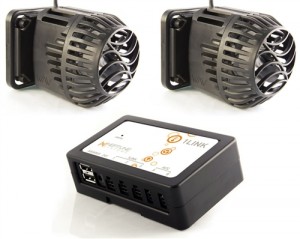 As the Neptune System’s Apex has evolved, the WAV is a great addition to apex user’s arsenal. It’s a high quality circulation pump, priced at a reasonable $ 499 for the starter kit (which contains two WAV pumps). The WAV integrates seamlessly with apex Fusion and offers a lot of data output about the speed of the pumps’ propellers, how many times per hour water volume is turned over and percentage of heat the pump is putting out. In my own personal power tests the WAV ranked as one of the lowest power consumers, even though in tank performance matched or bested that of other pumps. In addition the WAV automatically stops running if it’s removed from water, or falls onto the sand-bed, preventing dreaded sand storms.
As the Neptune System’s Apex has evolved, the WAV is a great addition to apex user’s arsenal. It’s a high quality circulation pump, priced at a reasonable $ 499 for the starter kit (which contains two WAV pumps). The WAV integrates seamlessly with apex Fusion and offers a lot of data output about the speed of the pumps’ propellers, how many times per hour water volume is turned over and percentage of heat the pump is putting out. In my own personal power tests the WAV ranked as one of the lowest power consumers, even though in tank performance matched or bested that of other pumps. In addition the WAV automatically stops running if it’s removed from water, or falls onto the sand-bed, preventing dreaded sand storms.
- neptune System’s PAR monitoring kit
 The PAR monitoring kit from Neptune System’s is by far the best PAR monitor available to serious reef aquarists. It’s the first system to offer easy 24/7 monitoring of active radiation levels. It is easy to install, and fully integrates with apex Fusion tracking the amount of energy available to photosynthetic animals. Even better, the PAR meter comes with a piece of live rock which easily disguises it in the tank. For data hungry aquarists, it’s a valuable addition to the Apex’s monitoring capabilities.
The PAR monitoring kit from Neptune System’s is by far the best PAR monitor available to serious reef aquarists. It’s the first system to offer easy 24/7 monitoring of active radiation levels. It is easy to install, and fully integrates with apex Fusion tracking the amount of energy available to photosynthetic animals. Even better, the PAR meter comes with a piece of live rock which easily disguises it in the tank. For data hungry aquarists, it’s a valuable addition to the Apex’s monitoring capabilities.
- Eshopps channel design sumps
 Eshopps isn’t a brand common on the aquariums of high profile aquarists. They certainly don’t have the knack for design like Synergy Reef sumps, and other custom brands. Although Eshopps has been making good quality aquarium equipment for a long time, and their channel design sumps are no exception. The channel design allows for very little water movement through the refugium and separates each sump chamber nicely. The skimmer has an obvious and independent chamber, along with water input and mechanical filtration. Eshopps did a good job of incorporating a chemical media basket into the sump, right in an area where water flow is at its greatest. A probe rack is tucked away neatly in a sump corner and everything fits together into a convenient package. The channel design sump is a vast improvement over Eshopps previous offerings, and should attract the attention of serious aquarists. It’s also a value, costing far less than a custom designed sump even though it has a robust suite of features.
Eshopps isn’t a brand common on the aquariums of high profile aquarists. They certainly don’t have the knack for design like Synergy Reef sumps, and other custom brands. Although Eshopps has been making good quality aquarium equipment for a long time, and their channel design sumps are no exception. The channel design allows for very little water movement through the refugium and separates each sump chamber nicely. The skimmer has an obvious and independent chamber, along with water input and mechanical filtration. Eshopps did a good job of incorporating a chemical media basket into the sump, right in an area where water flow is at its greatest. A probe rack is tucked away neatly in a sump corner and everything fits together into a convenient package. The channel design sump is a vast improvement over Eshopps previous offerings, and should attract the attention of serious aquarists. It’s also a value, costing far less than a custom designed sump even though it has a robust suite of features.
- Nyos reef aquarium test kits
 NYOS is a fairly new brand, offering everything from skimmers, down to reef cement (more on that later). While I’ve not used their skimmer, their test kits are easy to use and easy to read. I replaced all my old test kits with NYOS kits after using their nitrate kit. The NYOS carbonate hardness test kit consists of only two liquids, with each drop of one signifying 1 degree of carbonate hardness. This makes it super easy to test dKH. Their calcium test is also easy to use, and even their magnesium test is simple, accurate and easy to read.
NYOS is a fairly new brand, offering everything from skimmers, down to reef cement (more on that later). While I’ve not used their skimmer, their test kits are easy to use and easy to read. I replaced all my old test kits with NYOS kits after using their nitrate kit. The NYOS carbonate hardness test kit consists of only two liquids, with each drop of one signifying 1 degree of carbonate hardness. This makes it super easy to test dKH. Their calcium test is also easy to use, and even their magnesium test is simple, accurate and easy to read.
- Eco Tech Vectra return pump
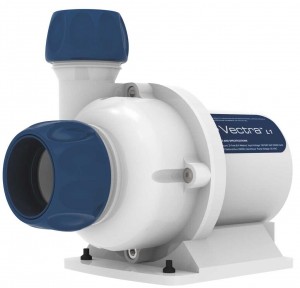 It’s hard not to include the Vectra among some of the best products of 2015. Control features aside, it’s a very well built and high performing return pump. Couple that with Ecosmart Live and unique calibration (that suits the pump directly to the tank it’s running) and Eco Tech has another great product. The Vectra is innovative enough to make aquarists consider upgrading an existing return pump, and should certainly be on the short-list of anyone in need of a new return.
It’s hard not to include the Vectra among some of the best products of 2015. Control features aside, it’s a very well built and high performing return pump. Couple that with Ecosmart Live and unique calibration (that suits the pump directly to the tank it’s running) and Eco Tech has another great product. The Vectra is innovative enough to make aquarists consider upgrading an existing return pump, and should certainly be on the short-list of anyone in need of a new return.
Now that I’ve shared some of the products and methods that worked out well in my tank over the course of 2015 so far, here are some products that didn’t impress me, and didn’t last long in my equipment closet.
- Mardel’s Parashield
 This medication from Mardel is marketed as a reef safe remedy for common marine parasites. I purchased some after reading about the product online. It seemed promising, as Para Shield uses essential oils to target external parasites and improve slime coat. Since protective mucous coating is normally recorded when fish fight off a parasite, this seemed like a good approach. Since essential oils either dilute in seawater, or harm invertebrates, Mardel combined them with an enzyme that is positively charged. Since fish are negatively charged, the medication is literally supposed to stick to fish, ignoring any sensitive invertebrates and doing its job before being diluted. I didn’t use the medication in a reef tank (and wouldn’t recommend it) but found that it did absolutely nothing to combat a common ich infection. I would suggest aquarists grab a proven remedy, (copper, formalin, hyposalinity) when combating an external parasite, and leave ParaSheild on the store shelf.
This medication from Mardel is marketed as a reef safe remedy for common marine parasites. I purchased some after reading about the product online. It seemed promising, as Para Shield uses essential oils to target external parasites and improve slime coat. Since protective mucous coating is normally recorded when fish fight off a parasite, this seemed like a good approach. Since essential oils either dilute in seawater, or harm invertebrates, Mardel combined them with an enzyme that is positively charged. Since fish are negatively charged, the medication is literally supposed to stick to fish, ignoring any sensitive invertebrates and doing its job before being diluted. I didn’t use the medication in a reef tank (and wouldn’t recommend it) but found that it did absolutely nothing to combat a common ich infection. I would suggest aquarists grab a proven remedy, (copper, formalin, hyposalinity) when combating an external parasite, and leave ParaSheild on the store shelf.
- Nualgai
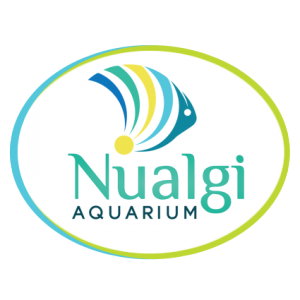 There isn’t much that Nualgi doesn’t promise to correct. I used the product when it first debuted and found it entirely ineffective, but decided to give it another shot, hoping for improvement. Same results as last time. Nualgai claims to pack your aquarium water with beneficial diatoms, which eat up the food source of nuisance algae and improve water quality. It also claims to increase coral coloration and growth. I used it on a nano-reef and suspended dosing other additives to see the effects. Nothing happened, other than increased algae growth and diminished water quality. Nualgi claims their product works wonders in commercial water purification, and perhaps it does, but in my experience it does very little to help reef aquariums. It’s also pricey for an additive, and regular, consistent maintenance of your tank will offer far more benefits.
There isn’t much that Nualgi doesn’t promise to correct. I used the product when it first debuted and found it entirely ineffective, but decided to give it another shot, hoping for improvement. Same results as last time. Nualgai claims to pack your aquarium water with beneficial diatoms, which eat up the food source of nuisance algae and improve water quality. It also claims to increase coral coloration and growth. I used it on a nano-reef and suspended dosing other additives to see the effects. Nothing happened, other than increased algae growth and diminished water quality. Nualgi claims their product works wonders in commercial water purification, and perhaps it does, but in my experience it does very little to help reef aquariums. It’s also pricey for an additive, and regular, consistent maintenance of your tank will offer far more benefits.
- NYOS reef cement
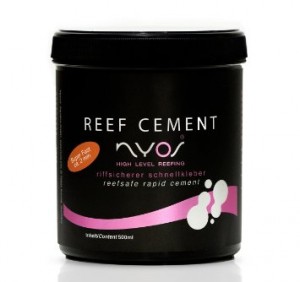 NYOS certainly nailed it with their test kits, not so much with their reef cement. It’s tough to get a workable consistency out of this stuff, and it turns the aquarium murky within seconds of hitting the water. To make matters worse, once it cures NYOS’ cement doesn’t really hold corals all that well. If they don’t fall while trying to get them in place, within a few days it seems like cemented corals hit the sand. Considering there are far more effective adhesives out there (Eco Tech’s coral glue) I would leave NYOS reef cement at the store. One thing it’s effective at is making a mess.
NYOS certainly nailed it with their test kits, not so much with their reef cement. It’s tough to get a workable consistency out of this stuff, and it turns the aquarium murky within seconds of hitting the water. To make matters worse, once it cures NYOS’ cement doesn’t really hold corals all that well. If they don’t fall while trying to get them in place, within a few days it seems like cemented corals hit the sand. Considering there are far more effective adhesives out there (Eco Tech’s coral glue) I would leave NYOS reef cement at the store. One thing it’s effective at is making a mess.
There it is, some good and some bad from 2015. Luckily, at least in my experience, there were a lot more good things that came out of 2015 (reef wise at least) than bad. Take note, everything mentioned here is my personal experience with methods and products, and I can’t guarantee that each and every aquarist will have the same result, good or bad.








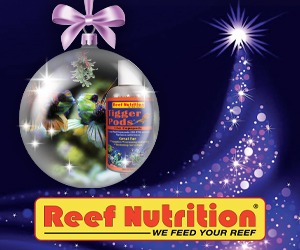
Ok